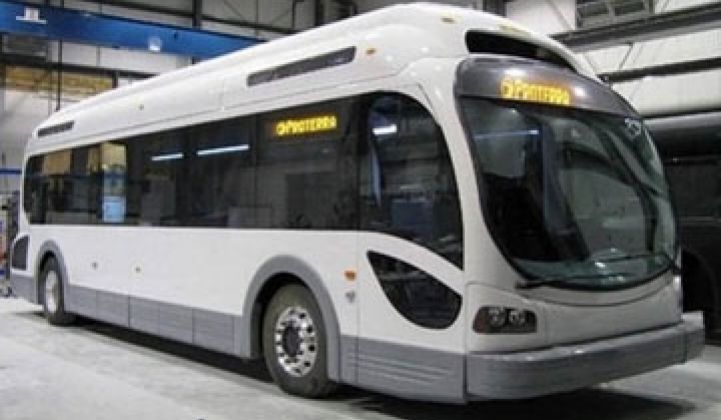A new electric vehicle will hit the streets of Southern California later this week that has a larger battery pack than a Tesla Roadster and which can be fully charged in ten minutes or less.
It also holds up to 68 passengers.
Foothill Transit, a public transportation agency serving San Gabriel and Pomona, has purchased three EcoRide BE35 all-electric buses and two charging stations from Proterra. If the initial launch goes well, Foothill may expand to a fleet of 12 electric buses. San Antonio will also soon put Proterra buses on its streets. Contracts with transportation agencies in North and South America may follow by the end of the year.
Proterra showed off a prototype of its bus and charging station in San Jose last year (see video) but the Foothill contract marks the first commercial deployment.
Why electrify buses? Predictability. Buses are the mules of the road, driving fixed routes at moderate speeds. The Foothill Transit route the EcoRides will ply is eight miles long and the buses will lumber along at an average speed of around 12 miles an hour. As a result, Foothill only needs two chargers -- which hang on poles similar to telephone poles -- to make sure the buses can complete their circuits. Limited range means limited range anxiety.
"It is a well-matched situation," said CEO Jeff Granato. "We know exactly how far it is going. You can predict how much range a vehicle will need."
The minimal number of charging points will in turn give Proterra the economic wiggle room to come to market with rapid, high-speed charging. Most electric car companies and car-charging outfits will start with standard chargers, which can take hours to fully charge a car. A Proterra bus can completely be charged in ten minutes or less.
Quick, on-road charging was a requirement, according to Felicia Frieseman at Foothill. The agency earlier had a requirement that an electric bus would have to go 30 miles on a charge. Buses could do that, but recharging would then take several hours.
"Having a bus that we had to take out of service after one run was not practical," she said.
This predictability further permits Proterra to minimize the size of the battery. The buses on the Foothill circuit will have 72-kilowatt-hour battery packs. That's just 50 percent bigger than the one in the two-seater Tesla Roadster (53 kilowatt hours).
"It will run for three hours," said Granato. "We consider that to be oversized."
The San Antonio buses will have 54-kilowatt-hour battery packs and charge more frequently. While the Foothill buses will likely spend 10 minutes every hour charging and do several laps, the San Antonio buses might take small sips of power on nearly every lap.
Minimizing the battery pack reduces the cost and increases the mileage without reducing the functionality, thanks to the rapid chargers. Proterra designed the battery pack and battery management system. The batteries come in 550-pound, 18-kilowatt-hour modular units. Altairnano supplies the cells. Granato further added that the batteries get one-third of their power from regenerative braking.
The buses, he added, also fare well against the diesel hybrids gaining in popularity. Those buses get about 4.5 miles a gallon, only slightly better than the 2 to 3.8 miles per gallon of regular diesel buses. Proterra's early buses get the equivalent of 17 to 18 miles per gallon and the figure will rise to 25 miles per gallon. (Side note: as a passenger, I can also confirm that the silence of the electric buses is more pleasing than the cacophony of engine noise one is subjected to while sitting on a diesel bus.)
Some startups and transportation agencies in China are experimenting with swappable batteries. With swappable batteries, a public charging infrastructure isn't required. On the other hand, buses have to go to centralized swapping stations during the middle of the day -- sometimes several times each day -- for batteries. Whether an agency goes with swapping or charging depends on geography and other issues.
But unlike cars, not everyone is a potential customer. The three buses and two chargers Foothill bought cost $5.6 million. Municipalities and the occasional large fleet owners constitute the buying public. Still, regulations will help. By 2012, 15 percent of the buses purchased by municipal agencies in California will have to be zero-emissions vehicles. Some of the large mega-cities of Asia have passed diesel regulations, as well.
Frieseman noted that the buses cost more than regular diesel buses, but added that maintenance will be lower. The agency will gather data to determine the total cost of ownership.



